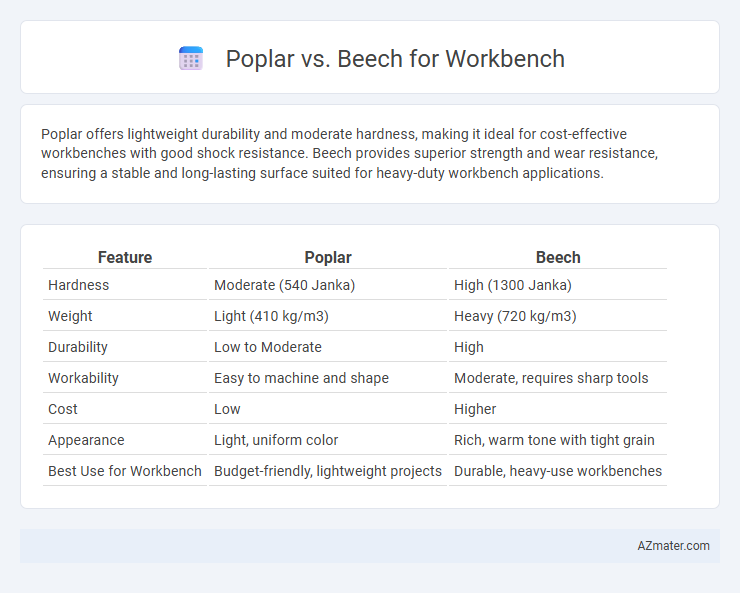Poplar offers lightweight durability and moderate hardness, making it ideal for cost-effective workbenches with good shock resistance. Beech provides superior strength and wear resistance, ensuring a stable and long-lasting surface suited for heavy-duty workbench applications.
Table of Comparison
| Feature | Poplar | Beech |
|---|---|---|
| Hardness | Moderate (540 Janka) | High (1300 Janka) |
| Weight | Light (410 kg/m3) | Heavy (720 kg/m3) |
| Durability | Low to Moderate | High |
| Workability | Easy to machine and shape | Moderate, requires sharp tools |
| Cost | Low | Higher |
| Appearance | Light, uniform color | Rich, warm tone with tight grain |
| Best Use for Workbench | Budget-friendly, lightweight projects | Durable, heavy-use workbenches |
Introduction: Choosing the Right Wood for Your Workbench
Poplar and beech are popular wood choices for workbenches, each offering unique properties that impact durability and workability. Poplar is lightweight and easy to machine, making it ideal for hobbyists and light-duty benches, while beech provides superior hardness and shock resistance, suitable for heavy-duty applications. Selecting between poplar and beech depends on the specific requirements of strength, stability, and intended use of the workbench.
Poplar vs Beech: Quick Overview
Poplar offers lightweight, stable wood with a fine, even grain ideal for workbenches requiring durability without heavy weight. Beech, known for its hardness and resistance to wear, provides a robust, dense surface that withstands heavy use and impacts better than poplar. Choosing between poplar and beech for a workbench depends on balancing lighter handling and moderate durability against superior strength and longevity.
Workbench Strength and Durability Comparison
Poplar wood offers moderate strength and durability, making it suitable for lightweight workbenches but less ideal for heavy-duty applications due to its softer grain. Beech wood provides superior strength and hardness, enhancing workbench durability and resistance to wear, which is crucial for demanding woodworking tasks. The dense structure of beech ensures a robust, long-lasting surface capable of withstanding significant impacts and heavy tool use, outperforming poplar in overall durability.
Poplar: Pros and Cons for Workbench Construction
Poplar is favored for workbench construction due to its lightweight nature and ease of machining, offering good dimensional stability and a smooth surface suitable for finishing. It is more affordable than beech, making it a cost-effective choice for large work surfaces; however, poplar is softer and less durable, leading to potential dents and scratches over time under heavy use. In contrast, beech provides superior hardness and wear resistance, but its higher density makes it heavier and more expensive, which may not be ideal for portability or budget-conscious projects.
Beech: Pros and Cons for Workbench Construction
Beech wood offers excellent strength and durability, making it ideal for workbench construction that requires a sturdy and long-lasting surface. Its fine grain and smooth texture provide a stable and resilient workspace, although beech can be susceptible to moisture-related warping if not properly sealed. Compared to poplar, beech is harder and more wear-resistant, but typically comes at a higher cost and requires more effort in finishing.
Work Surface Wear and Maintenance
Poplar workbenches offer moderate work surface wear resistance suitable for light to medium tasks, requiring regular maintenance such as sealing or oiling to prevent dents and moisture damage. Beech provides superior durability against surface wear and can withstand heavy-duty use with minimal surface damage, demanding less frequent maintenance and simpler refinishing processes. Choosing beech ensures a longer-lasting, resilient workbench surface ideal for intensive applications with lower upkeep costs.
Cost Differences: Poplar vs Beech
Poplar wood typically costs less than beech, making it a budget-friendly option for workbenches. Beech offers greater durability and strength, but this premium quality comes at a higher price point. Choosing poplar reduces upfront expenses while beech ensures longer-lasting performance, influencing overall project costs.
Workability and Tool Friendliness
Poplar offers superior workability compared to beech due to its softer texture and lighter weight, making it easier to cut, shape, and sand with hand and power tools. Beech, while more durable and harder, tends to dull tools faster and requires more effort during machining, reducing tool longevity and increasing maintenance. Choosing poplar for a workbench top enhances tool friendliness, enabling smoother woodworking and reducing wear on blades and bits.
Aesthetic Appeal: Grain, Color, and Finish
Poplar features a fine, straight grain with a smooth texture and typically exhibits pale cream to greenish hues, making it ideal for painted finishes on a workbench. Beech showcases a tight, uniform grain pattern with warm, reddish-brown or pinkish tones that enhance natural wood finishes, providing a rich and classic aesthetic. Both woods offer excellent finish adherence, but beech's color depth and grain complexity deliver a more visually striking workbench surface.
Final Recommendation: Which Wood Should You Choose?
Poplar is easier to work with due to its softer texture and lighter weight, making it ideal for beginners or projects requiring fine detailing on a workbench. Beech offers superior durability and hardness, providing enhanced stability and resistance to wear, which is crucial for heavy-duty or long-lasting workbench surfaces. For a balance of affordability and workability, choose poplar; for strength and longevity, beech is the recommended wood for your workbench.

Infographic: Poplar vs Beech for Workbench
 azmater.com
azmater.com